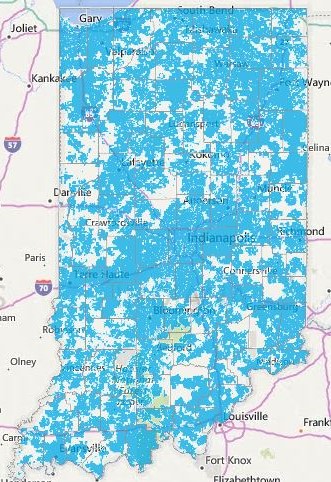Welcome
Recent News
Microsoft Rural Broadband Effort Getting Underway (July 2019) - An effort by Microsoft Corp. to expand rural broadband access in Indiana is moving forward. The company says it has tapped Ohio-based Watch Communications to begin the development process to connect communities in 50 Indiana counties to high-speed internet.
The partnership is part of the Microsoft Airband Initiative, which the company in December announced was being expanded to several states, including Indiana. The agreement with Watch Communications will also benefit areas in Illinois and Ohio. Read more.
On August 31, 2018, Lt. Governor Suzanne Crouch announced that the Federal Communications Commission has awarded more than $29M in funding over the next ten years to increase broadband speeds for 24,530 locations throughout the state. The FCC is looking to close the digital divide between rural and urban America and has awarded almost $1.5B to unserved areas in 45 states. Fifty-three percent of the homes and businesses selected for coverage will receive download speeds of at least 100 megabits per second. For more information, visit this website.
Research
- Estimation of the Net Benefits of Indiana Statewide Adoption of Rural Broadband
- Benefit-Cost Analysis for Implementation of Rural Broadband in the Tipmont Cooperative in Indiana. Click here to read more about the study.
- "Unlocking the Digital Potential of Rural America" Report - click here.
OCRA Involvement
Next Level Connections Grant Program
The Next Level Connections Broadband Grant Program is designed to promote access to broadband service to all areas of the state which is necessary for a highly functioning 21st century economy. As part of Governor Holcomb’s broader Next Level Connections infrastructure program, it is a significant investment of $100 million for the deployment of broadband. The program builds on infrastructure investments made through industry funds as well as prior and ongoing grant programs. Visit this page to learn more.
Broadband Readiness Planning Grant
This planning grant will help communities gain an understanding of their current broadband conditions and needs, create a long-term vision of broadband in their community, and identify options for achieving that vision. The plan will have to meet all the normal CDBG program criteria, and the grant amount will limited to $50,000.
Once awarded the Purdue Center for Regional Development (PCRD) will provide technical assistance to the pilot communities. To learn more about this planning grant, visit our page.
General Information
Access to broadband and other communication services is critical for a functioning 21st century economy. Rural broadband is vital to ensuring our rural areas can continue to thrive, and when rural Indiana communities have quality broadband, they are able to keep pace with the rest of the state.
Broadband access is one of the five strategic frameworks of the Strategic Plan for Rural Indiana. Visit this page to learn more about how OCRA will facilitate strategies to address rural broadband access.
In March 2018, HB1065 was passed and a copy of the bill can be found here. To find more statistical information on broadband across the state click here to view information from Rural Indiana Stats.
Tell us about your service
We want to collect your feedback on broadband in your area. Please complete this short survey. We thank you for all the information can you provide.
What is broadband?

Broadband can be delivered by one of the following methods:
- Fiber optic cable: technology that converts signals carrying data through glass fibers.
- Digital Subscriber Line (DSL): Transmitting data over already installed copper telephone lines
- Cable modem: TV cables are utilized to transmit data.
- Wireless, fixed or mobile: Connects devices to a local internet service “over the air” via electromagnetic waves.
- Satellite: Transfers data through a 2-3’ dish, modem and clear line of sight to a satellite.
- 1 kbps (kilobits/second) = 1,000 bits per second.

- 1 mbps (megabits/second) = 1 million bits per second.
- 1 gbps (gigabits/second) = 1 billion bits per second.
Previous State Broadband Plan
In 2014, former Lt. Governor Ellspermann initiated a Rural Broadband Working Group (RBWG) with Secretary of Commerce Victor Smith. Stakeholders were asked to participate in a series of meetings to identify challenges and issues that hinder the expansion of broadband service into rural areas. Members of the RBWG included service providers, economic developers, rural related associations, and university representatives. The working group met six times from March through September of 2014. These sessions were guided by a problem solving process designed to help identify key challenges and then work towards recommendations to help solve the problem. Read the full report here.
Current Indiana Statewide Broadband Strategic Plan
In 2019, Lt. Governor Crouch, along with the Office of Broadband Opportunities (OBBO), convened a Rural Broadband Stakeholder Group. Participants included providers, business leaders and both the public and private sectors. Over several meetings, these stakeholders engaged in discussions covering a wide range of broadband related topics.
Using the insights gathered during these meetings, the OBBO created a strategic plan to promote the benefits of expanding broadband to Hoosier families and businesses in unserved and underserved areas. Read the full report here.
State Government Resources
Federal Resources
The federal government has multiple programs, funding, and oversight related to broadband. USDA and the FCC are two of the main providers of loans and grants for broadband deployment. USDA has grant and loan programs available and the FCC also has a grant program and other information.
Complaints relating to internet service should be directed to the Federal Trade Commission.
USDA
- Rural Broadband Access Loan and Loan Guarantee
- Telecommunications Infrastructure Loans & Loan Guarantees
- Community Connect Grants
Federal Communications Commission (FCC)
BroadbandUSA
The National Telecommunications and Information Administration’s (NTIA) BroadbandUSA program promotes innovation and economic growth by supporting efforts to expand broadband access and meaningful use across America. BroadbandUSA serves local and state governments, industry and nonprofits that seek to expand broadband connectivity and promote digital inclusion. BroadbandUSA’s services are driven by the needs and interests of state and local broadband leaders, and focus on supporting planning efforts, helping to identify funding, and advising on local broadband program.
Sustaining Broadband Networks: A Toolkit for Local and Tribal Governments pdf
This toolkit presents an action plan to maintain and sustain a broadband network. This guide contains best practices and lessons learned from broadband programs. It is meant to help both local governments who entered into public-private partnerships and ISPs ensure that those networks are sustainable.
Implementing a Broadband Network Vision: A Toolkit for Local and Tribal Governments pdf
This toolkit builds on NTIA’s previous guidance on plotting a broadband roadmap and examines how that work can inform a broadband implementation strategy. It includes a nine-step process that outlines how to implement broadband networks from conception to operation.
America's Libraries: Connectivity that Transforms pdf

